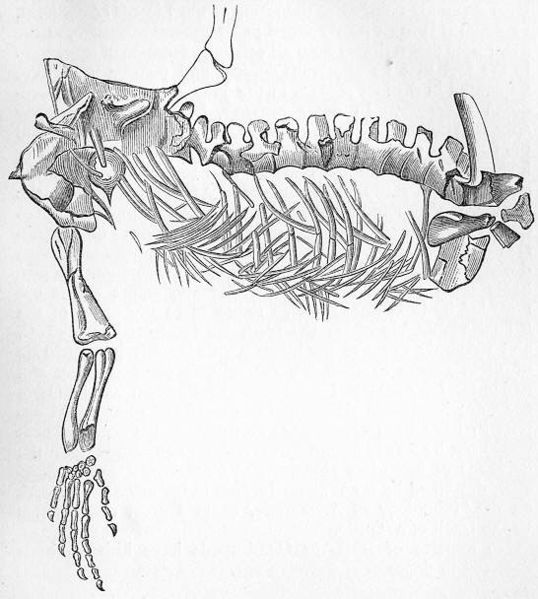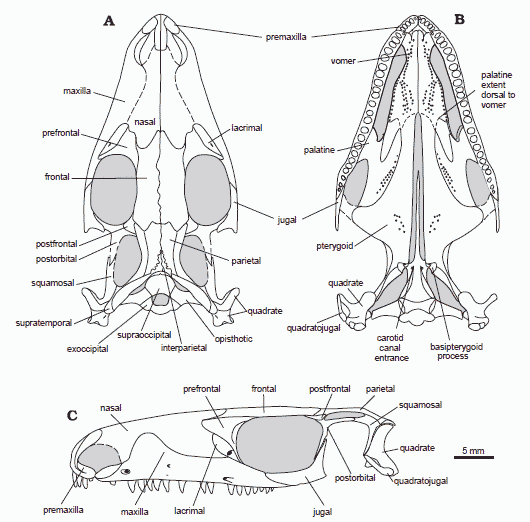
| Archosauromorpha | ||
| The Vertebrates | Archosauromorpha |
| Vertebrates Home | Vertebrate | Vertebrate |
|
Abbreviated Dendrogram
Diapsida
├─Lepidosauromorpha
│
└─○Archosauromorpha
├─"Protorosauridae"
│ ├─Czatkowiella
│ └─Protorosaurus
└─┬?─Choristodera
├?─Chelonii (molecular phylogeny)
├?─Helveticosaurus
└─┬─Rhynchosauria
└─┬─Trilophosauria
└─┬─Prolacertiformes
├─Drepanosauridae
└─Archosauria
|
Contents
Overview |
 |
| Life restoration of Prolacerta broomi, an archosauromorph from the Induan of South-west Gondwana. Length about 60 cm. Protorosaurus speneri would have been very similar in appearance. The long neck and long hind limbs (for bursts of bipedal running) represent the basal or primitive archosauromorph condition, from which the various more specialised types evolved. Illustration by Ghedoghedo (Wikimedia) |
Archosauromorpha: Buzzards > Lizzards
from the Middle Permian.
Sauria : Lepidosauromorpha + * : Protorosauridae + (?Choristodera + ?Helveticosaurus + ??Chelonia (according to molecular phylogeny, otherwise Anapsida or Lepidosauromorpha) + (Rhynchosauria + (Trilophosauria + (Prolacertiformes + Drepanosauridae + Archosauriformes)))).
Cervical ribs with 2 heads; concave-convex articulation of astragalus & calcaneum; premaxilla extends dorsally behind nares & excludes maxilla; teeth in sockets; neck with 7-8 vertebrae; centra not deeply amphicoelous; pisiform usually absent in carpus; primitively, calcaneal tuber extends laterally beyond articulating surface of calcaneum (pulley for gastrocnemius – more upright position?).
Links: The Triassic Takeover with numerous links); Reptilian Systematics. Archosauromorpha - Wikipedia, the free encyclopedia has a short discussion, outlining the enormous scope of this group. Archosauromorpha has a similar, somewhat fuller discussion, in the same vein, in Spanish. You can get a sense of this diversity directly at Mikko's Phylogeny or on the Taxonomicon. There is also an on-line (no figures) version of Chris Brochu's review of archosaur systematics and phylogenetic problems at Journal of Paleontology- Progress and future directions in ... . Several sites discuss Archosauromorpha as background to the study of dinosaurs; for example Dinosaur Origins. Comparative Anatomy Topic 3 - Archosaurs and Archosauria- More on Morphology have introductions to the anatomy of the group. Some of John Hutchinson's archosaur mechanics papers (destined to be classics) can found here and there, including here. ATW051001. (phylogeny MAK101007)
Protorosauridae: (= Archosauromorpha?) Protorosaurus, Czatkowiella.
Middle Permian to Early Triassic of Europe.
Archosauromorpha : ?Choristodera + ?Helveticosaurus + ??Chelonia + (Rhynchosauria + Trilophosauria + (Prolacertiformes + Drepanosauridae + Archosauriformes)) + * : Czatkowiella + Protorosaurus.
Comments: Although cladograms by Borsuk-Białynicka & Evans, 2009 unite Protorosaurus and Czatkowiella, there are few, if any, clear synapomorphies (unique shared features that define a clade as having a common ancestor apart from other related forms) and this is probably a paraphyletic group. MAK101007
 |
| Protorosaurus speneri. From Henry Alleyne Nicholson, 1876, The Ancient Life History of the Earth, Project Gutenberg (public domain). (also on Wikimedia commons) |
Protorosaurus: Protorosaurus speneri von Meyer, 1830.
Synonym: Proterosaurus (variant spelling)
Kupferschiefer, late Middle Permian (Capitanian) of East Germany
Protorosauridae : Czatkowiella + *.
From Zittel/Eastman/Woodward 1902 (copyright expired) "Attaining a length of 1.5 m. Vertebral centra completely ossified, and united with their neural arches by suture. Intercentra occur only between the cervical vertebrae, which are elongate, and bear slender ribs. Skull tapering anteriorly, its structure not clearly shown.Hind limb considerably longer than the fore, and distal tarsals less than five in number. Upper Permian (Kupferschiefer) of Thuringia and Hesse, and Magnesian Limestone of Durham, England."
Comments: The earliest known Archosauromorph. Although frequently illustrated as a complete skull and skleleton, or life reconstruction, and often mentioned, this is a poorly known form. Included first in the Euryaspida, later in the Prolacertiformes. Although similar to Prolacerta, there are many aspects of its anatomy that are still controversial (Benton 1985), and it may have a more basal position. (Borsuk-Białynicka & Evans, 2009). Although usually reconstructed as semi-aquatic, these animals were more probably fully terrestrial, very similar in lifestyle and appearance to extant monitor lizards (Varanidae). It is quite likely that the Protorosaurs and Prolacertifomes simlarily used gular pumping of the hyoid skeleton to ventilate the lungs more efficiently. (Dr John Merck - Archosauromorpha). The life- reconstruction of Prolacerta at the top of the page could equally apply to Protorosaurus or the related Czatkowiella.
Links: Wikipedia - Dinocasts com life-sized cast (along with replica fossils and reconstructions of other permian fauna) very nice although the grass spoils the effect (grass didn't appear until the early Tertiary) MAK101008
 |
| The basal archosauromorph Czatkowiella harae, Early Triassic of Czatkowice, Poland. Reconstruction of the skull, (length about 4 cm) in dorsal (A), ventral (B), and lateral (C) views. from Borsuk-Białynicka & Evans, 2009. This was a long necked animal very similar in appearance to, but smaller than, Protorosaurus and Prolacerta |
Czatkowiella: Czatkowiella harae Borsuk-Białynicka & Evans, 2009.
Late Olenekian of Poland
Protorosauridae : Protorosaurus + *.
long slender neck, three headed ribs on some anterior dorsal vertebrae, and short broad neural spine tips in the dorsal vertebrae.
Comments: resembles Protorosaurus but differs enough to justify distinct generic status. Both show diagnostic long-necked "prolacertiform" characteristics (loss of the parietal foramen, distinct transverse processes on the dorsal vertebrae, double-headed ribs), but cladistic analyses does not recover a monophyletic Prolacertiformes. Czatkowiella and Protorosaurus represent basal archosauromorphs with few specialised or common characteristics; the traditional prolacertiforms, like the younginiformes, probably represent a basal assemblage grouped together because of shared primitive (plesiomorphic) characteristics the retention of primitive character states. If ichthyosaurs, sauropterygians, and testuduines are archosauromorphs, they would derive from this early evolutionary assemblage of long-necked lizard-like forms.
References: Borsuk-Białynicka & Evans, 2009.
Links: Wikipedia MAK101007
checked ATW050908
Using this material. All material by ATW is public domain and may be freely used in any way (also any material jointly written by ATW and MAK). All material by MAK is licensed Creative Commons Attribution License Version 3.0, and may be freely used provided acknowedgement is given. All Wikipedia material is either Gnu Open Source or Creative Commons (see original Wikipedia page for details). Other graphics are copyright their respective owners